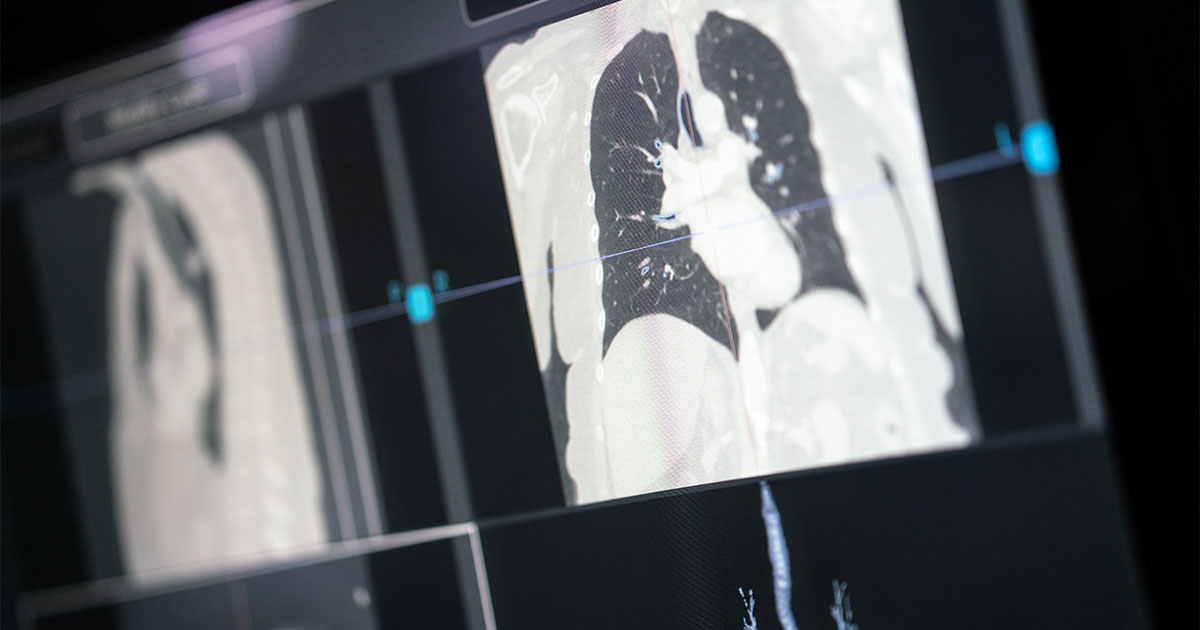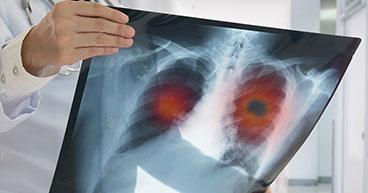
Lung cancer, the third-most common cancer in America, is also the deadliest, accounting for 22 percent of all cancer deaths every year, according to the National Cancer Institute. But today, the outlook for patients diagnosed with lung cancer is better than ever. After decades of relatively unchanging lung cancer survival rates, researchers are now reporting promising trends at every stage of the disease.
This is largely attributed to people living longer with non-small cell lung cancer (NSCLC), which accounts for roughly 80 percent of all lung cancer cases. Researchers believe this trend is due to fewer people smoking and to advances in screening and treatments.
“People are more aware today that smoking is dangerous,” says Sagun Shrestha, MD, Medical Oncologist and Hematologist at Cancer Treatment Centers of America® (CTCA), Phoenix. “That’s huge.”
In this article, we’ll explore this encouraging trend about lung cancer survival. Topics include:
- Lung cancer survival statistics
- The reasons people are living longer with lung cancer, including:
- How the pandemic may impact trends
- Lung cancer care at CTCA®
If you’ve been diagnosed with lung cancer and would like to learn more about your treatment options, or if you’re interested in a second opinion about your lung cancer diagnosis and treatment plan, call us or chat online with a member of our team.
Lung cancer survival statistics
Lung cancer is the most common cancer to affect both men and women, and it’s the third-most common overall, behind breast cancer and prostate cancer. More than 235,000 Americans are diagnosed with lung cancer each year, and more than 130,000 die from the disease annually.
The rates of new cases and deaths has been declining over several decades, but both categories have seen significant declines since the early 2000s. For instance:
- The percentage of people living at least three years after a lung cancer diagnosis rose from 19 percent in 2001 to 31 percent in 2018.
- The average survival rate also increased during that time, from eight to 13 months.
Early-stage lung cancer incidence jumped from 17 percent in 2004 to 28 percent in 2018. But that’s a good sign, according to researchers, because it means more lung cancer cases are being caught earlier.
The U.S. Preventive Services Task Force (USPSTF) first started recommending lung cancer screenings in 2013—a move that appears to have had an important impact: The overall rate of people dying from lung cancer dropped 56 percent from 1990 to 2019 in men, and 32 percent from 2002 to 2019 in women.
What's behind the numbers?
Fewer people smoking
Tobacco use is still the leading cause of preventable disease, disability and death in the United States—and lung cancer remains the leading cause of cancer death. Yet the overall risk of death from lung cancer has decreased, mostly because people are smoking less.
The current rate of U.S. adults who smoke is 12.5 percent—down from 20.9 percent in 2005.
Fewer people smoking also means less secondhand smoke, which also is a leading risk factor for lung cancer. Other risk factors include:
- Radon exposure
- Age—cancer risk increases as we get older
- Family history
- Exposure to asbestos or pollutants
Greater awareness
Experts give credit for part of the encouraging trend to education efforts on the dangers of tobacco use.
Last year, the U.S. Centers for Disease Control and Prevention (CDC) gave out more than $96 million in grants to state governments and other groups for promotional efforts on tobacco danger awareness. According to the CDC, states that made larger investments in comprehensive tobacco control programs have seen larger and faster declines in smoking. And they’ve saved money thanks to those declines: For every $1 spent on a program, a state receives an estimated $55 return on investment, mainly due to prevented health care costs.
The CDC and other national organizations like the American Lung Association also work with insurers, health care providers and employers to support people who want to quit using tobacco. Quitting tobacco is especially important for cancer patients. The Office of the Surgeon General reports that smoking increases the likelihood that treatments for all types of cancer will fail. And research shows that those who quit smoking after a cancer diagnosis may be able to tend to improve their overall health and reduce their risk of other diseases or a secondary cancer.
Medical advances
These gains are coming at a time when lung cancer treatment is also improving.
In the past decade, treatments like surgery, radiation therapy and chemotherapy for lung cancer have seen important advances, and several new treatments have become available.
These new treatments include:
- Video-assisted thoracoscopic surgery
- Small molecule inhibitor drugs that target common genetic driver mutations in lung cancer tumors, such as epidermal growth factor receptor (EGFR) and anaplastic lymphoma kinase (ALK) tyrosine kinase inhibitors
- Checkpoint inhibitors that help the immune system better attack tumors.
Since 2015, the U.S. Food and Drug Administration (FDA) has approved several classes of immunotherapy drugs for advanced lung cancer that exhibits certain genomic mutations. Some patients receiving this type of treatment are living for years, and a few have been able to stop treatment and continue to do well.
Significant strides in the field of genomics have led to many of these advances. Researchers understand the biology and workings of lung cancer tumors better than ever before. Just this March, a team from the Mount Sinai Health System published a new method they developed to identify aggressive, early-stage lung adenocarcinoma—the most common type of lung cancer—and target it with drugs known as aurora kinase inhibitors.
Updated screening guidance
Early detection is also critical to lung cancer outcomes. The five-year survival rate for advanced lung cancer is 6 percent. For early-stage cancer, it’s 60 percent.
In 2021, the USPSTF updated its recommendations for lung cancer screenings to account for emerging evidence on the importance of early detection for people at high risk. Now, it calls for a low-dose CT scan for anyone between the ages of 50 and 80 who has smoked at least 20 pack years. A pack year is the equivalent of smoking one pack of cigarettes a day for one year.
“We’re doing more screening but still not as much as we’d like to see,” Dr. Shrestha says. “It’s important to remember, though, that lung cancer is treatable at any stage, and we have treatments now that can help people with lung cancer live longer and with a better quality of life.”
How the pandemic may impact trends
Despite the good news, more people are expected to die from cancer over the next decade because of screening interruptions caused by the pandemic. A 2021 study found that between March and May 2020 alone, more than 9 million Americans missed their routine screenings. Over the past two years, researchers found significant drop-offs in lung cancer screening rates—about 45 percent fewer per month—at large health care systems across the United States.
“I do think the pandemic is affecting how many people are getting screened and diagnosed with lung cancer,” Dr. Shrestha says. “I’ve seen a lot of people lately whose cancer we could have caught at an early stage if they’d come in two years ago, but who, because they waited, are now getting diagnosed with stage 4 cancer.”
A recent United Kingdom study found that the number of early-stage lung cancer cases decreased by 18 percent during the beginning of the pandemic—from 196 per year in 2018-2019 to 160 in 2020. The study also found that the number of lung cancer patients who received treatment within six months of their diagnosis decreased from 54 percent in 2018-2019 to 46 percent in 2020.
Lung nodule and lung cancer screening and treatment at CTCA
At CTCA, we've seen many patients left stressed for weeks or months after finding out they have nodules in their lungs. They either didn’t have clear answers about their lung nodules or weren’t comfortable with the answers they received. We also know how crucial time is when it comes to diagnosing and treating lung cancer. That’s why we created our rapid lung-nodule diagnosis program at CTCA Phoenix and CTCA Chicago, with results delivered in as few as four days.
Working together, we can better identify whether your lung nodules are suspicious for cancer. If they are, we schedule the appropriate tests as quickly as possible. And if you do have malignant nodules and a lung cancer diagnosis, you can get started with treatment right away.
At CTCA, we use a wide range of treatments and technologies to treat lung cancer, including:
Your lung cancer treatment team may consist of several doctors, each of whom practices a specific area of medicine. Your team may include a:
- Pulmonologist
- Thoracic surgeon
- Medical oncologist
- Radiation oncologist
These doctors work in collaboration to answer your questions and recommend treatment options based on your specific cancer and individual needs.
If you’ve been diagnosed with a lung nodule or lung cancer, you may also want to consider getting a second opinion. Many patients come to CTCA for a second opinion because all we treat is cancer—and because we recognize the importance of focusing on a single disease with specialized programs like our Lung Cancer Centers.
Our cancer experts have access to a wide range of diagnostic technology and comprehensive treatment options, such as genomic testing, targeted therapy and clinical trials. And our tumor board consists of interdisciplinary experts, including an interventional radiologist, an interventional pulmonologist, a thoracic surgeon, a medical oncologist and a radiation oncologist—all reviewing your CT scans and medical records together.
If you’ve been diagnosed with a lung nodule or lung cancer and would like to learn more about your diagnostic and treatment options, or if you’re interested in a second opinion about your diagnosis and treatment plan, call us or chat online with a member of our team.



